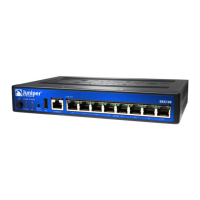Chapter 11
SRX100 Services Gateway
Autoinstallation
This chapter includes the following section:
■ SRX100 Services Gateway Autoinstallation Overview on page 53
SRX100 Services Gateway Autoinstallation Overview
The autoinstallation process begins any time a services gateway is powered on and
cannot locate a valid configuration file in the internal flash. Typically, a configuration
file is unavailable when a services gateway is powered on for the first time or if the
configuration file is deleted from the internal flash. The autoinstallation feature
enables you to deploy multiple services gateways from a central location in the
network.
If you are setting up many devices, autoinstallation can help automate the
configuration process by loading configuration files onto new or existing devices
automatically over the network. You can use either the J-Web configuration editor
or the CLI configuration editor to configure a device for autoinstallation. The J-Web
interface does not include Quick Configuration pages for autoinstallation
For the autoinstallation process to work, you must store one or more host-specific
or default configuration files on a configuration server in the network and have a
service available—typically Dynamic Host Configuration Protocol (DHCP)—to assign
an IP address to the services gateway.
Autoinstallation takes place automatically when you connect an Ethernet port on a
new services gateway to the network and power on the device. To simplify the
process, you can explicitly enable autoinstallation on a device and specify a
configuration server, an autoinstallation interface, and a protocol for IP address
acquisition.
For more information about configuring autoinstallation, see the JUNOS Software
Administration Guide .
Related Topics ■ Connecting the SRX100 Services Gateway to the Power Supply on page 45
■ Grounding the SRX100 Services Gateway on page 47
■ Powering On and Powering Off the SRX100 Services Gateway on page 48
■ SRX100 Services Gateway Basic Connectivity Overview on page 55
SRX100 Services Gateway Autoinstallation Overview ■ 53

